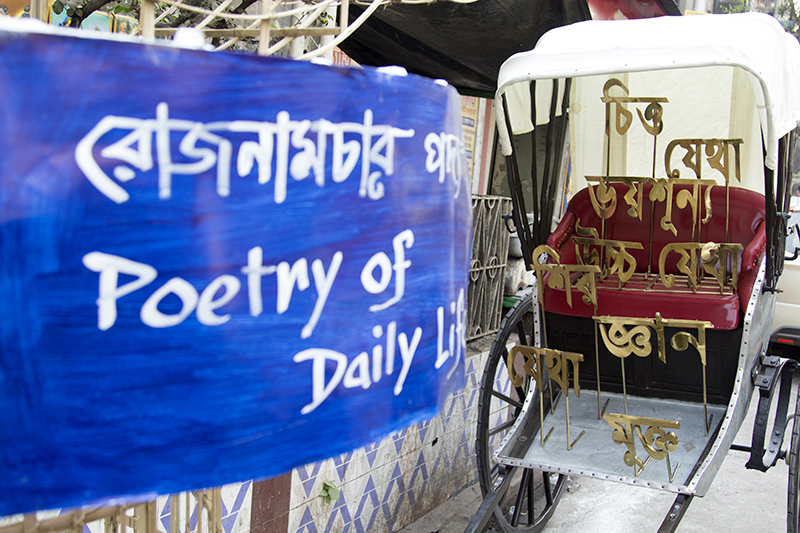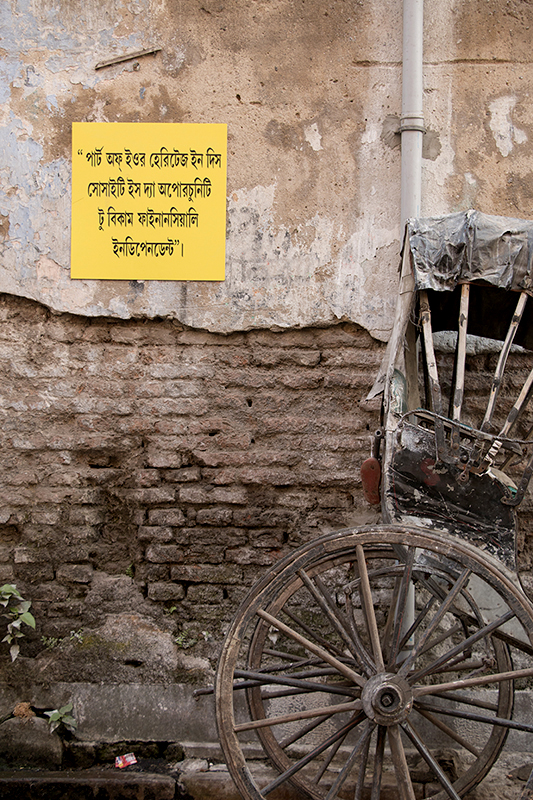Sumona Chakravarty




Grant Period: Eight months
Sumona Chakravarty is a visual artist, designer and arts manager. She was trained in Art and Design from Srishti School of Art, Design and Technology, Bangalore. She is an ATSA fellow (2014) and has a Masters degree in Art and Design for Civic Engagement from the Harvard University Graduate School of Design, USA. She conceived and leads the ‘Chitpur Local’ project run by the Hamdasti Collective. Hamdasti is an artists’ collective based in Kolkata that aims to strengthen the relationships between people, communities and their neighbourhoods in the city. They believe art and design play a critical role in creating public platforms for dialogue, interaction, civic participation and social engagement, in this case for the historic locality of Chitpur. ‘Chitpur Local’ is an ongoing initiative and Varshita Khaitan and Nilanjan Das of Hamdasti are collaborating with her for this edition of the project. Varshita is an alumnus of Srishti School of Art, Design and Technology, Bangalore and now works as a freelance graphic designer in Kolkata. Nilanjan is a printmaker based in Kolkata with an MFA from Rabindra Bharati University now pursuing PhD.
Chitpur is one of the oldest localities in Kolkata that prospered as a business district during the colonial period. The area housed many cultural bodies, local businesses and arts and crafts communities. However, the importance of Chitpur has dwindled with passing time; shabby roads with dense traffic and poor localities mark the area now. A hub of traditional business and art forms, the historical importance of the place is rapidly fading. The project ‘Chitpur Local’ aims to revitalise the memory of that history and heritage among the locals as well as the citizens of Kolkata, thus also reimagining what Chitpur could mean to the city in the contemporary times. The last edition of the project that was supported by IFA witnessed the artists of Hamdasti collaborating with local businessmen, old residents, other artists, and the teachers and students of the Oriental Seminary School, located in Chitpur. Eminent culture and heritage practitioners like Naveen Kishore, Partha Ranjan Das, Paula Sengupta and GM Kapur mentored the project and it received widespread recognition.
For most ‘Community Arts’ projects artists parachute into localities, use its people and stories as material for creating their own work, and leave without any sustained relation or effect on the life of the community. This extractive process of working has been detrimental for both the arts and the communities. Chitpur Local has become a significant exception to that mode of working. The artists have been working with the community for about four years now and they have entered into various collaborative engagements that have enabled strengthening of bonds between them. Many of the local businesses have started using the expertise of the artists to push the boundaries of their traditional business, while the artists have come to understand the complexity of the people and their lives in the area. As a result, their understanding of the project too has vastly improved, becoming more empathetic and nuanced. The upside of such strong connections is that the artists see themselves embedded in the community and contributing to it; but the downside is that sometimes the local demands take the edge off their artistic interventions.
Growing recognition of the project has meant that more institutions and families in the area are welcoming them and other artists want to join the project. This grant supports the current edition of ‘Chitpur Local’ which aims to bring these two threads together to build more interactions in the community. Eight artists across practices have worked with the community for a year to develop various sub projects that was framed in the proposal for this edition of Chitpur Local. Over the coming eight months they are going to build various kinds of interactions with the community through workshops and community events. These are as follows:
- The Courtyard – Printmaker and Installation artist Anuradha Pathak is going to explore the role of the Dalan (the courtyard) in joint families, working with the Mitra, Sen and Dawn families around the making of the Durga idol. The idea is to reimagine the role of the courtyard in the context of modern joint families and the extended community.
- Mapping the Neighbourhood through Stories – Curator Ruchira Das will work with the students of the Sri Bidya Niketan Girls High School to map the neighbourhood through stories. She aims to explore the confluence of narratives shaping histories and identities by initiating conversations between various generations of the locality.
- The Signature Campaign – Local clubs play significant social and political role in old localities of Kolkata. Sculptor Dipyaman Kar will engage them in a process of participatory games, debate and dialogue to create public awareness about urban conservation. He aims to engage with the political process of the locality and challenge a prevalent romantic association with the past.
- Matrimonial Photo Studio – Arts researcher and writer Srota Dutta will collaborate with the historic photo studios in the neighbourhood to showcase 19th century photography techniques and use the format of a matrimonial advertisement portrait to create dialogues around women’s identities and shifting notion of beauty.
- Witness – Visual artist Suhasini Kejriwal sees art making as an act of ‘witnessing’ - foregrounding everyday stories, recording loss, marking significance, distilling meaning, and vocalising aspirations. She will be working with Bholanath Das, the owner of a stamp shop and signage making studio, to innovatively reuse signage making techniques. Typography will be used as a tool for bearing witness to the changing landscape of the locality.
- The Other Side of the Popup Museum – Graphic designer Varshita Khaitan’s Popup Museum was one of the highlights in the last edition of ‘Chitpur Local’. This time she wants to engage people who are Hindi speakers, the non-Hindu groups and the female students who remained at the margins of the project last time. Due to the nature of her target group, she will adopt a more private approach to create a more inviting and inclusive environment. Her popup museums might be ‘hidden’ this time, or may be available for select audiences.
- Print Catalogue – Printmaker Nilajan Das has been working with the local printmakers and blockmakers for a long time. In this edition he wishes to create a bridge between the local printers and the larger community of artists, designers and makers in Kolkata. He will map all local print studios, identify and facilitate potential collaborations to explore new artistic and commercial uses of printmaking. He will also develop a series of ‘print catalogues’ that capture the process and open up local printing techniques for a wider audience.
- Jorabagan Encounters – Sumona herself has been able to establish a connection to the local police station at Jorabagan. In the last edition she often had to work with the local police officers. She found many of them are deeply interested in arts and wanted to host parts of the project in their premises. She wishes to use the police station as a temporary cultural structure to build new kinds of interactions between members of the locality and the police. By turning the police station into a place of play she hopes to shift the hierarchies that otherwise create challenge in everyday interaction and excludes the space from the cultural life of the communities.
There will be an exhibition of the works created out of these. The interaction will continue after the exhibition as well. They will work to equip the community members for long term collaboration with national and international artists.
The Trustees of IFA have emphasised the need of supporting continuous engagements where artists have shown dedication and deep engagement to a certain project. The last grant to Sumona Chakravarty has shown such promise. The work of Hamdasti led by Sumona has been pushing the norms of what is usually understood as ‘community project’ in our context. Importantly, it puts the ‘public’ back into public art. They have presented their work at the Mumbai Art Room where they created a community museum experience and conversations were generated around the idea of the artist’s role in community. In Bangalore they participated in a residency organised by Jaaga where they presented their work and interacted with other artists to push the idea of community participation in the arts. This edition aims to create a larger symbiotic web between the artists and the members of the local community, which will enable giving the ownership of the project back to the community where they will be able to sustain it.
The outcome of the project will be a series of workshops and a final exhibition. The whole process will be documented through video and still photography. These audio-video documents will be deposited to IFA as deliverables. These materials will also be available on their website and social media pages which are already functional. Given the scope of the project the budget is detailed and justified.
